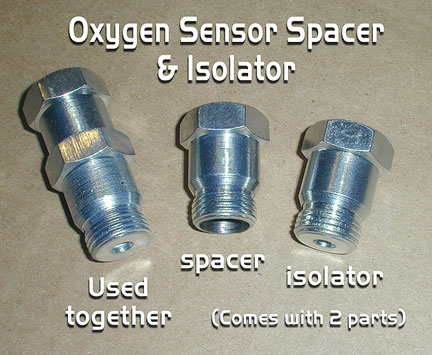The spacers and isolators we make are 18mm ( large spark plug thread ) Fits most car's O2 sensor threaded socket. If they will NOT fit your O2 sensor threaded socket, then send us your spacer and or isolator back for a full refund. Anti-seize lubricant is a good idea to coat the threads of your spacer and or isolator. Simply threading your O2 sensor from the exhaust pipe, using a 18mm wrench. Vehicles '96 (OBD II )and newer, have two O2 sensors, one right after your exhaust manifold (pre) and one after your catalytic converter (post). Some Chevy trucks have four O2 sensors. 1987 vehicles (OBD I ) have only one O2 sensor. 18mm wrench will take out the sensor. Be careful not to damage the sensor tip and don't touch the tip part. Most O2 sensors will fit inside the spacer. if not send back and we will gladly return your money.
Also not some of the rear O2 sensors need a larger opening inside the O2 spacer. The O2 spacer is 17/32" or just a hair bigger than 1/2" dia O2 sensor will fit. We can go up to 9/16" just e-mail us and we can sell you more bored out spacers.
The advantage of having the"Oxygen Sensor Spacer" backing it out of the way of the exhaust flow. It allows you to tune your air/fuel ratio by hooking up a potentiometer to your oxygen sensor (and or) your MAP sensor. More information on how to lean your fuel can be found on this page.
Frequency Asked Questions about the "O2 Spacers & Isolators"
What do they actually do ? Designed to get rid of the open loop and not sense too much oxygen, therefore not triggering the "check light"
If you don't get the "check engine code - oxygen sensor " you will be a happy camper with your oxy spacer.
The spacers & isolators are NOT to control the air/fuel mix.
------
On a water for fuel type of forum someone said :
O2 sensor "isolators" DO NOT WORK! They do exactly opposite of what is claimed. The O2 sensor output would have to be RAISED in voltage to lean out the mix. Taking the sensor out of the exhaust stream lowers the temperature, which LOWERS the voltage and causes the ECU to richen up the fuel air mix ratio! It also causes the sensors to foul prematurely and the ports on the sensor get all filled with carbon.
Here's an idea. Before altering your emissions system, TRY running it stock with the booster for a while and see if the ECU will re-learn, to work with the boost. After the initially poor results, it will usually compensate the other way and results should improve. Many are having success doing exactly this!
----------------
Answer to the above :
I have found that the spacers actually do get hot, no problem, maybe not max. heat. Maybe more heat due to the extra metal around the sensor that is threaded into the exhaust manifold, with more metal mass than before. If you run hydroxy gas, the carbon build up will go away. Without hydroxy gas , yes they will fill and build up with carbon and clog the sensors from working. Hey, maybe we want them not to work?
Answer to the above : The problem we run into when running ?hydrogen assist? is, we burn our fuel too cleanly and then the oxygen sensors read as if the mix is too lean and either richens the fuel mix or in the case where extreme amounts of hydrogen is assisted, you get a super clean burn and then the system goes into open loop, hence, the dreaded check engine light.
The only thing the "O2 Spacers & Isolators" are good for is helping turn off the check engine light.
Therefore, if you don't have a check engine light, you don't need the O2 spacers.
Answer to the above : If you're getting a check engine light, they absolutely DO WORK. As said above, the ECU will relearn that the air/fuel mix is incorrect and will compensate, hence, excellent fuel economy and in some cases as much as 100% better. Depending upon the size of the engine and driving habits.
The O2 spacers are work good for the 4 oxy sensor Chevy trucks, use one EFIE on the first left oxy sensor & use spacers on the other 3 - oxy sensors.
The vehicles where you install the spacer/isolator, and the oxy sensor light goes on and puts it into "open loop" mode (dead oxy sensor mode) then it WILL NOT work. A gamble of $10.00 for many years of saving gas mileage in your current car.
We hope this helps you. We are here to help. More information on running your car green, click here. |





